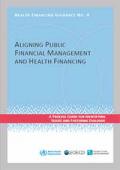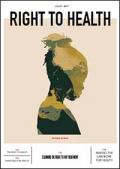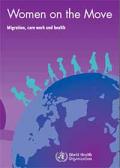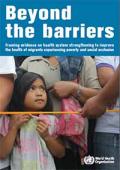What's New
Displaying results 1931 - 1940 of 4914

Resource | Guidelines,
This guide lays out an illustrative process for health and finance authorities to engage in productive dialogue, assess the current situation in terms of how aligned the public financial management (PFM) system and health financing system are, and work towards a joint policy roadmap to improve alignment. It builds on a previous document “Aligning public financial management and health financing: sustaining progress toward universal health coverage,” which considers how PFM and health financing systems can be better aligned in support of UHC, and provides a framework to examine common challenges, as well as offering strategies to address them. This guide can serve as an entry point for that dialogue, and can facilitate a structured approach for health, finance and other stakeholders to discuss underlying issues before implementing system changes that might affect the PFM and health financing system.

Resource | Publications,
This book, arising from the Adelaide conference, is intended for the international Health in All Policies (HiAP) community – including people who are already practising HiAP and aim to sustain it, helping those who are thinking about doing HiAP to progress, and helping others to start planning HiAP.
The case studies in this book highlight the diversity of applications of HiAP and its multiple processes, dimensions and outcomes in different countries and regions and political systems. It includes experiences of HiAP at the city level, such as in Quito, Ecuador, at the regional/state level such as in California and the national level, for example in China. While there are many different versions of and contexts for HiAP, there are also some shared lessons across countries and regions.

Resource | Publications,
Our 2016 report, Lessons learned from national initiatives to end child marriage, explores what lessons can be drawn from the increasing number of national strategies, action plans, and country-wide initiatives to address child marriage around the world, particularly in relation to their implementation across sectors.
This report considers the experiences in 11 countries: Bangladesh, Burkina Faso, Chad, Egypt, Ethiopia, Ghana, Mozambique, Nepal, Uganda, Zambia and Zimbabwe. It will be of particular interest to Girls Not Brides members in countries where (i) a national initiatives is still in development, (ii) is about to be rolled out, or (iii) is currently being implemented.

Resource | Fact Sheets,
Adolescence is a period of great change and opportunity. Investments in promoting adolescent health and wellbeing can have far reaching effects for individuals and communities, positively impacting a country’s ability to develop and thrive.
Since 1984, the USAID-funded Demographic and Health Surveys (DHS) Program has collected, analyzed, and disseminated nationally representative data on population, health, HIV, and nutrition through more than 300 surveys in 90 countries.

Resource | Publications,
The right to the highest attainable standard of physical and mental health is a human right. References to the right to health are found in international and regional law, treaties, United Nations declarations, and national laws and constitutions across the globe. The right to health guarantees everyone a system of health protection and the freedom to make decisions about their health regardless of who they are, where they live, what they believe or what they do. Elements of the right to health include access to health services, including access to sexual and reproductive health services. Fulfilling the right to health is inter-related with and interdependent upon other rights including the right to adequate sanitation, food, decent housing, healthy working conditions and a clean environment.
The new report from UNAIDS, Right to Health, highlights that the people most marginalized in society and most affected by HIV are still facing major challenges in accessing the health and social services they urgently need. However, the report also gives innovative examples of how marginalized communities are responding.

Resource | Guidelines,
This guideline provides global, evidence-informed recommendations on protection, promotion and support of optimal breastfeeding in facilities providing maternity and newborn services, as a public health intervention. It is intended to contribute to discussions among stakeholders when selecting or prioritizing appropriate actions in their efforts to achieve the Sustainable Development Goals and the global targets for 2025 as put forward in the Comprehensive implementation plan on maternal, infant and young child nutrition, endorsed by the Sixty-fifth World Health Assembly in 2012, in resolution WHA65.6, the Global strategy for women’s, children’s, and adolescents’ health (2016–2030), and the Global Strategy for infant and young child feeding.

Resource | Publications,
A global paradox is emerging in which care workers - who are largely migrant women, often working in informal home settings - make a considerable contribution to public health in many countries but are themselves exposed to health risks, face barriers to accessing care, and enjoy few labour and social protections.
WHO has produced a new report on this population group, collating evidence across sectors. This report breaks new ground in casting a wide net across disciplines – health, labour, employment, social protection, social services, law, immigration, cross-border movement and citizenship – to shed light on a particular population group that both provides care as well as needs it to maintain their own health and well-being. It looks at the lives of these migrant women care workers as well as the situation for their households left behind. It takes a transnational perspective appropriate to our interconnected world.

Resource | Publications,
"Leaving no one behind" is a centrefold principle in the Sustainable Development Agenda. Those "left behind" are a vastly heterogeneous group. They face a wide range of barriers to health services that differ across countries, communities and individuals. As such, approaches to health system strengthening to leave no one behind need to account for this heterogeneity and the complexity of barriers. Some migrants, in particular those experiencing poverty and social exclusion, face intersecting and compounding barriers.
This paper emphasizes that leaving no one behind entails full realization of human rights, without discrimination on the basis of sex, age, race, colour, language, religion, political or other opinion, national or social origin, property, birth, disability or other status.

Resource | Guidelines,
Since the first edition was published in 2000, Managing Complications in Pregnancy and Childbirth has been translated into several languages and today is used widely in training for and the provision of emergency obstetric care. The new edition brings the guidance in the manual into line with WHO’s current recommendations for emergency obstetric and newborn care.
While most pregnancies and births are uneventful, all pregnancies are at risk. Around 15% of all pregnant women will develop a potentially life-threatening complication that calls for skilled care, and some will require a major obstetrical intervention to survive. This manual is written for midwives and doctors at the district hospital who are responsible for the care of women with complications of pregnancy, childbirth or the immediate postpartum period, including immediate problems of the newborn.

Resource | Publications,
The NACP-IV (2012-2017) has entered in the last year of its implementation. NACP-IV aims to consolidate the gains made till now while making further strides with a goal of accelerating reversal and integrating response. NACP-IV had two objectives - Reduce new infections by 50% (2007 Baseline of NACP-III) and provide comprehensive care and support to all persons living with HIV/AIDS and treatment services for all those who require it.





